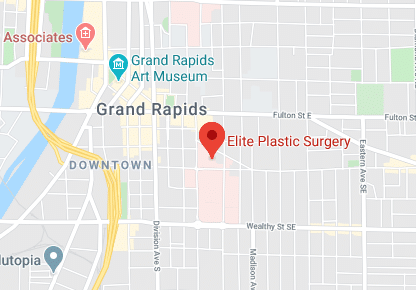
In July’s first blog, we went through the three main forms of skin cancer, basal cell carcinoma, squamous cell carcinoma, and melanoma. Basal cell and squamous cell lesions both grow slowly and with regular visits to a dermatologist (especially if you’ve had lots of sun exposure in your youth) can be easily diagnosed and removed. Often all that’s needed is a curette to basically scoop out the lesion and close the spot with a stitch or two. Melanoma can be a different thing, as it doesn’t always show up on the areas that receive the most sun. Still, early diagnosis returns great success in stopping its progression.
The problem is — most people rarely, if ever, go to a dermatologist. And when they do find a lesion that is now bleeding and crusty, it may have developed to the point that it’s going to be challenging to remove the growth and repair the skin in the area. This is especially true on the face.
For those scenarios, the board-certified plastic surgeons at Elite Plastic Surgery are your resource to provide this surgical reconstruction.
Here are some methods we may use.
Repairing the excision location
Skin cancer is the most common form of cancer. It occurs and is diagnosed more than all other forms of cancer combined. Often skin cancers are allowed to grow unchecked before the person knows they are there. That’s when removal will be more difficult and probably out of the comfort zone for most dermatologists. You need expert plastic surgery to remove the growth and reconstruct the skin to keep from disfiguring your appearance.
We perform both sides of these procedures, removing the lesion and reconstructing the skin. Here are some of the skin cancer reconstruction options we use at Elite:
- Excision and closure — This is the simple form of skin cancer removal, and it is usually performed right in your dermatologist’s office. He or she removes the small growth, often with a curette or small scalpel excision, and applies a stitch or two to close the wound.
- Excision with skin graft — In this case, the lesion was larger, and the sides could not be brought together without leaving a large scar. A skin graft is taken from another area of the body and placed on the excision area.
- Local flap — If the affected area is larger, excision creates a need for more skin than a graft can provide. Here tissue is moved from an adjacent area to the wound. It remains attached to its blood supply.
- Free flap — A free flap is a piece of skin, fat, and muscle that is completely removed from a donor site with an artery and a vein, and it is transferred to the recipient site. The artery and vein are then connected to vessels in that area. Sometimes, the flap may need time to fully take hold before the skin is trimmed and sutured into place.
If your dermatologist has found a large skin cancer lesion, it could be a good time to call the expert surgeons at Elite Plastic Surgery for skin cancer reconstruction. Call us at (616) 459-1907 to schedule an appointment.


Comments are closed.